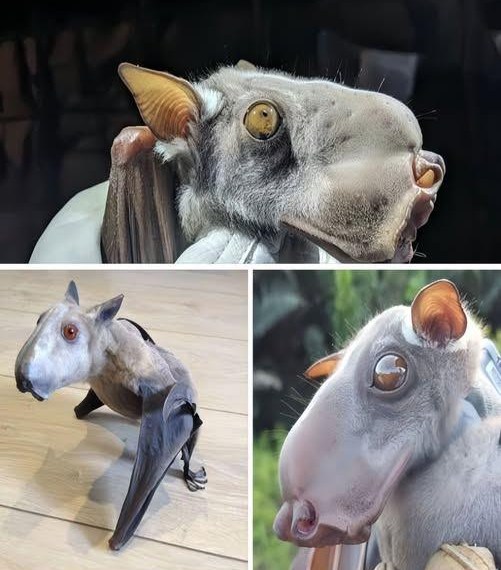The Hammerhead Bat: Africa’s Oddball Guardian of the Forest

The Hammerhead Bat: Africa’s Oddball Guardian of the Forest
Deep in the tropical forests and swampy regions of Central and West Africa, as twilight bleeds into the night, a shadow with wings takes to the skies. Its flight is slow, deliberate, and hauntingly graceful. From a distance, it might look like any other bat. But as it soars closer, one cannot ignore the bizarre and commanding silhouette of its head—oversized, stretched, almost alien. This is the Hammerhead Bat (Hypsignathus monstrosus), Africa’s largest bat species and undoubtedly one of the most surreal-looking mammals on the planet.
The male Hammerhead Bat is a spectacle of evolution. Its head is large and flattened, resembling a hammer or mallet—hence the name. But this isn’t just a cosmetic oddity. The grotesquely enlarged snout houses an impressive system of vocalization: bulbous resonating chambers, muscular lips, and inflated larynxes that allow the male to produce deep, honking calls that echo through the forests at night. These are the bat’s mating calls, performed in nighttime “lekking” rituals where multiple males gather and compete for the attention of passing females. Picture it as a bat version of a jazz club, with each male crooning to win the heart of an airborne passerby. This is sexual selection at its most theatrical.

Females, in contrast, look like an entirely different species. They are smaller, with more modest, streamlined heads that resemble your typical fruit bat. They lack the bombastic voice boxes of the males and don’t participate in vocal courtship displays. But their role is just as critical: they are forest gardeners. Hammerhead Bats are frugivores, with a particular fondness for figs, mangoes, guavas, and bananas. As they fly across vast territories at night searching for food, they inadvertently disperse seeds across the forest, promoting growth and regeneration. In this quiet, unseen way, they keep the tropical ecosystem thriving.
Despite their ecological importance, Hammerhead Bats have not been treated kindly by human perception. Their large size (with wingspans up to 1 meter), eerie faces, and haunting calls have sparked myths and fear. In many regions, they are mistaken for omens or supernatural creatures. Worse, they are sometimes hunted for bushmeat or captured in local markets due to folklore surrounding their supposed powers. But these fears are unfounded. Hammerhead Bats are not predators. They do not drink blood, nor are they dangerous to humans. Their bizarre appearance is simply a result of evolutionary pressures tied to reproduction, not aggression.

Understanding the behavior of these bats helps demystify the myths. At night, males establish calling territories along riverbanks and clearings. They hang upside-down from low branches, puff out their throats, and emit their signature honking sounds every few seconds. Females fly past, assessing the performance of each male. If impressed, a female will land beside the singer, and mating will occur. Studies show that only a few males—usually those with the most powerful, resonant calls—succeed in reproducing, driving the evolution of such exaggerated vocal and physical traits.
Beyond their fascinating mating rituals, the Hammerhead Bat’s role in the ecosystem cannot be overstated. In a time when deforestation and climate change threaten forest biodiversity, species like these are frontline defenders. Every fruit they eat and every seed they scatter contributes to the health and resilience of tropical forests. They are pollinators, seed dispersers, and silent stewards of the canopy—much like bees are for meadows or birds for hedgerows. But unlike those familiar helpers, bats often work in the shadows, both literally and metaphorically.

Conservation efforts for bats face unique challenges. Unlike charismatic megafauna like elephants or tigers, bats often inspire fear or aversion. Their nocturnal habits, leathery wings, and association with disease (especially post-COVID) have unfairly painted them as villains. However, it’s critical to separate fact from fiction. There is no scientific evidence linking Hammerhead Bats to any direct disease transmission to humans. Like most wildlife, they only become a risk when their natural habitats are destroyed or when humans come into inappropriate contact with them.
Efforts are underway by conservationists and bat researchers to protect Hammerhead Bats and change public perception. Education plays a key role. By teaching local communities about the ecological services bats provide—such as improving fruit harvests through pollination—attitudes can shift from fear to appreciation. Ecotourism also presents a sustainable opportunity. Bat-viewing tours, similar to birdwatching, can generate income while promoting conservation awareness.

Capturing a Hammerhead Bat in flight—its wings spread wide, its hammer-shaped head silhouetted against the moon—is a scene of wild, gothic beauty. It reminds us that nature does not conform to human standards of “pretty” or “normal.” The Hammerhead Bat is a living example of nature’s endless creativity. It breaks the mold. It challenges expectations. And it quietly holds up an entire forest.
Despite their unconventional appearance, Hammerhead Bats embody many of the themes that resonate with us deeply: perseverance, misunderstood beauty, and the quiet importance of unseen roles. They do not roar like lions or dazzle like peacocks. Instead, they hum through the darkness, carrying the seeds of tomorrow in their bellies, singing their strange songs to the stars.

As our planet faces unprecedented environmental challenges, we must begin to see beyond appearances. To cherish the odd, the awkward, the unfamiliar—because often, these are the species holding the threads of life together. The Hammerhead Bat may not be a crowd-pleaser in a zoo, but in the vast stage of nature, it plays one of the most vital parts. We should be listening.
So the next time you hear a mysterious honk deep in the tropical night, don’t be afraid. It’s just nature’s opera singer calling out, keeping the rhythm of the forest alive.









